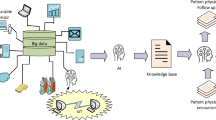Abstract
The diabetes is a critical disease from the small children to old age people. Due to improper diet and physical activities of the living population, obesity becomes prevalent in young generation. If we analyze self care of individual life, no man or women ready to spend their time for health care. It leads to problem like diabetes, blood pressure etc. Today is a busy world were robots and artificial machines ready to take care of human personal needs. Automatic systems help humans to manage their busy schedule. It motivates us to develop a diabetes motoring system for patients using IoT device in their body which monitors their blood sugar level, blood pressure, sport activities, diet plan, oxygen level, ECG data. The data are processed using feature selection algorithm called as particle swarm optimization and transmitted to nearest edge node for processing in 5G networks. Secondly, data are processed using DBN Layer. Thirdly, we share the diagnosed data output through the wireless communication such as LTE/5G to the patients connected through the edge nodes for further medical assistance. The patient wearable devices are connected to the social network. The Result of our proposed system is evaluated with some existing system. Time and Performance outperform than other techniques.






Similar content being viewed by others
Data availability
Not applicable.
Code availability
Not applicable.
References
Chen M et al (2017) Green and mobility-aware caching in 5G networks. IEEE Trans Wirel Commun 16(12):8347–8361
Sharkawy R, Ibrahim K, Salama MMA, Bartnikas R (2011) Particle swarm optimization feature selection for the classification of conducting particles in transformer oil. IEEE Trans Dielectr Electr Insul 18(6):1897–1907
Srinivasan D, Seow TH (2005) Particle Swarm Inspired Evolutionary Algorithm (PS-EA) for multi-criteria optimization problems. In: Abraham A, Jain L, Goldberg R (eds) Evolutionary Multiobjective Optimization. Advanced Information and Knowledge Processing. Springer, London. https://doi.org/10.1007/1-84628-137-7_7
Algarsamy A , Kathavarayan RS (2018) Classification with modified deep belief network for large dataset. Int J Eng Res Technol 11(10):1511-1524. ISSN 0974-3154
Tamilselvan P, Wang Y, Wang P, Sky B (2012) Deep Belief Network based state classification for structural health diagnosis. 2012 IEEE Aerospace Conference, Big Sky, MT, pp 1-11. https://doi.org/10.1109/AERO.2012.6187366
Hinton GE, Osindero S, Teh YW (2006) A fast learning algorithm for deep belief nets. Neural Comput 18:1527–1554
Hinton G (2010) A practical guide to training restricted Boltzmann machines. Momentum 9:1
Bengio Y, Lamblin P, Popovici D, Larochelle H (2007) Greedy layer-wise training of deep networks. In: Advances in Neural Information Processing Systems, p 153–160
Chen M, Yang J, Zhou J, Hao Y, Zhang J, Youn C (2018) 5G-Smart diabetes: toward personalized diabetes diagnosis with healthcare big data clouds. IEEE Commun Mag 56(4):16–23. https://doi.org/10.1109/MCOM.2018.1700788
Amine Rghioui J, Lloret SS, Oumnad A (2020) A smart architecture for diabetic patient monitoring using machine learning algorithms. Healthcare 8:348. https://doi.org/10.3390/healthcare8030348
Ahad A, Tahir M, Yau KA (2019) 5G-based smart healthcare network: architecture, taxonomy, challenges and future research directions. IEEE Access 7:100747–100762. https://doi.org/10.1109/ACCESS.2019.2930628
Ahad A, Tahir M, Sheikh MA, Ahmed K, Mughees A, Numani A (2020) Technologies trend towards 5G network for smart health-care using IoT: a review. Sensors 20:4047. https://doi.org/10.3390/s20144047
Mahmoud MM, Rodrigues JJ, Ahmed SH, Shah SC, Al-Muhtadi JF, Korotaev VV, De Albuquerque VHC (2018) Enabling technologies on cloud of things for smart healthcare. IEEE Access 6:31950–31967
Baker SB, Xiang W, Atkinson I (2017) Internet of things for smart healthcare: Technologies, challenges, and opportunities. IEEE Access 5:26521–26544
Qi J, Yang P, Min G, Amft O, Dong F, Xu L (2017) Advanced internet of things for personalised healthcare systems: A survey. Pervasive Mob Comput 41:132–149
Lloret J, Parra L, Taha M, Tomás J (2017) An architecture and protocol for smart continuous eHealth monitoring using 5G. Comput Netw 129:340–351
Xiao F, Miao Q, Xie X, Sun L, Wang R (2018) Indoor anti-collision alarm system based on wearable Internet of Things for smart healthcare. IEEE Commun Mag 56:53–59
Yoo H, Han S, Chung KA (2020) Frequency pattern mining model based on deep neural network for real-time classification of heart conditions. Healthcare 8:234
González-Valenzuela S, Chen M, Leung VCM (2011) Mobility support for health monitoring at home using wearable sensors. IEEE Trans Inf Technol Biomed 15:539–549
Abd El-Latif AA, Abd-El-Atty B, Mehmood I, Muhammad K, Venegas-Andraca SE, Peng J (2021) Quantum-inspired blockchain-based cybersecurity: securing smart edge utilities in IoT-based smart cities. Inf Process Manag 58(4):102549
Zhang WZ, Elgendy IA, Hammad M, Iliyasu AM, Du X, Guizani M, El-Latif A (2020) Secure and optimized load balancing for multitier IoT and edge-cloud computing systems. IEEE Internet Things J 8(10):8119–8132
Xu M, Peng J, Gupta BB, Kang J, Xiong Z, Li Z, Abd El-Latif AA (2021) Multi-agent federated reinforcement learning for secure incentive mechanism in intelligent cyber-physical systems. IEEE Internet Things J 16–23. https://doi.org/10.1109/JIOT.2021.3081626
Elgendy IA, Zhang WZ, He H, Gupta BB, Abd El-Latif AA (2021) Joint computation offloading and task caching for multi-user and multi-task MEC systems: reinforcement learning-based algorithms. Wirel Netw 27(3):2023–2038
Eberhart R, Kennedy J (1995) Particle swarm optimization. Proc IEEE Int Conf Neural Netw 4:1942–1948
Acknowledgements
This research was funded by Princess Nourah bint Abdulrahman University Researchers Supporting Project number (PNURSP2022R234), Princess Nourah bint Abdulrahman University, Riyadh, Saudi Arabia.
Author information
Authors and Affiliations
Corresponding author
Ethics declarations
Conflicts of interest/Competing interests
Enclosed separate disclosure.
Additional information
Publisher’s Note
Springer Nature remains neutral with regard to jurisdictional claims in published maps and institutional affiliations.
Rights and permissions
About this article
Cite this article
Venkatachalam, K., Prabu, P., Alluhaidan, A.S. et al. Deep Belief Neural Network for 5G Diabetes Monitoring in Big Data on Edge IoT. Mobile Netw Appl 27, 1060–1069 (2022). https://doi.org/10.1007/s11036-021-01861-y
Accepted:
Published:
Issue Date:
DOI: https://doi.org/10.1007/s11036-021-01861-y




